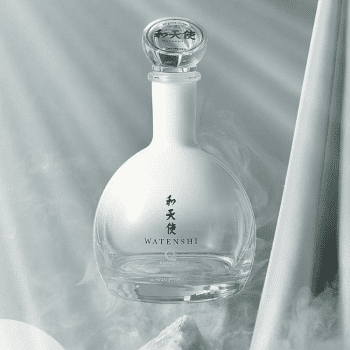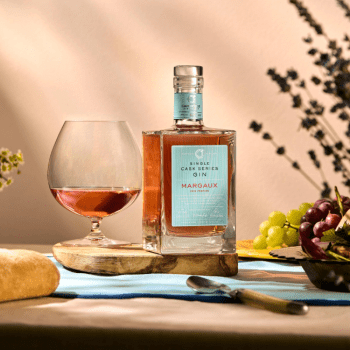Demand outstrips supply for ‘world’s most expensive gin’
The UK’s Cambridge Distillery has reported double-digit growth every year for its Watenshi Gin, which carries a price tag of £3,000 (US$4,021).

IWSR data revealed in June that gin sales in the UK fell by 14% last year and the category’s share of total alcohol consumption by 4%.
Speaking to The Spirits Business on premiumisation and the gin category’s place within it, Cambridge Distillery’s co-founder and master distiller William Lowe said he is “watching the slowdown in premiumisation happen to some brands”, but at the same time, “there are people who I think have got, quite frankly, just different definitions of what premiumisation actually means”.
He explained: “Over the past 10 years, there’s been a lot of people guilty of calling premiumisation, the act of making something a different colour and saying it’s handmade, and calling that premiumisation.
“I don’t think that there is any greater or lesser demand for premiumisation than there always has been, and probably always will be, but I do think that as time progresses, customers become more adept at determining what actually has been premiumised and what has been repackaged old stuff with nothing new that’s struggling to justify its price point.”
If premium means gin in the £30-£40 (US$40-US$53) price bracket, then Lowe wouldn’t be surprised to see this area stalling. “Almost all of that growth [for £30-£40 gin] in the last 10 years has been in synthetic flavourings and colourings. And of course, it’s stalling because people get sick of it. In that regard, I think I can definitely see that happening.
“I’m not in the flavoured market, so I don’t have an accurate in-house barometer for that, but I certainly get that impression that the fad has gone.
“We’re now in more flavoured gins than gin brands by degrees of magnitude. A position I’ve long held is the idea that as soon as a market can offer you more flavoured variants of a category, than of the category itself, then you’re at the tipping point for eventual decline.”
A slide in demand for gins of this nature is “good news” for Cambridge Distillery because, as Lowe explained: “There’s a disingenuous approach to premiumisation there – that I think has just been sort of played with and has failed – it’s done what it can do, but if those players fall away, then it leaves more room for the people who are truly involved in the pursuit of excellence.
“Then we get to a rather more pleasant scenario where there’s less noise and more music.”
If interest might be starting to fall at the lower-end of premium, Lowe is of the belief that on the other end of the scale it is doing the opposite and still growing, which is where Cambridge Distillery sits as an ultra-luxury gin.
He said: “It’s growing not only in volume and value, but also in the number of markets that we are active in and where that demand is coming from. And this is not something that’s confined to London by any means anymore.”
Watenshi
Lowe is the maker of Watenshi, which at the time of its introduction in 2015 was dubbed the ‘world’s most expensive gin‘, now clocking in at £3,000 (US$4,021). It is made from the tiny amount of angel’s share preserved from the distillery’s Japanese Gin (made with Japanese botanicals). On how the product is doing nearly a decade since it hit the market, he said: “The demand outstrips the supply, we’re about to enter its 10th year celebrations in 2025 and there has been double-digit growth every year since we first launched it.

“The thing that really makes me smile every time I think of Watenshi is that whenever people buy it, they always try and buy it again. This isn’t a trophy hunter’s product that sits there on the shelf as a prize. This is a product intended for and used for consumption and enjoyment. People love it. They buy it again, which is a wonderful position to be in.”
On justifying Watenshi’s price (and the rest of the distillery’s expressions, albeit they are much lower in the £80-£200 range), he added that “the reason that [our] products are able to command much greater price points is that they’re vastly more labour intensive, and as a result, they achieve a vastly greater quality stamp.
“I believe that quality is a tangible, demonstrable thing, and if it isn’t, then it isn’t. If you can’t prove it, then it’s probably not there. And people who are actively pursuing greater quality to demonstrate what it is that they’re delivering for the extra money, I don’t see that slowing down in the slightest.”
Referencing IWSR data where the company’s highest-price category is deemed ‘luxury’, or ‘luxury-plus’, (US$100 and over), Lowe noted that “if you look at the total numbers that they’ve got in that category, we outsell the rest of the world combined by three-to-one.
“We are the world leaders in luxury gin – about 75% of the global market share. In that regard, do I see premiumisation slowing down? No.”
However again, in viewing premiumisation as a “broad brush”, for flavoured gins, rather than a ‘slowdown’ he has seen an “almost complete stop of people trying to bring another flavour to market, for say £37”.
“That I think, has definitely seen its course,” he asserted.
“I think on the colours and flavours end, really, all your product has to do is be good enough. It doesn’t have to be outstanding. It just has to be not bad. If you’re matching the occasion with the demand, then it’s fine – but these sort of fads will come and go. After the main rush of the second gin renaissance has been and gone, it will be those quality producers that remain.”
Innovation not for innovation’s sake
Although Cambridge Distillery uses what could be considered ‘innovative’ ingredients (such as ants) in the makeup of its gins, that has never been an aim of the distillery. “Innovation in itself, it has never been our goal. Our goal is just quality,” Lowe maintains.
“Innovation is nothing more and nothing less than experimentation when it meets success. It’s very easy to be different. It’s being different successfully, that’s what makes an innovator.

“Now, if there is a traditional route towards getting to a greater quality, then great. But I mean, you’ve seen the level of the gin industry prior to Cambridge Distillery – it was impossible to sell a bottle of gin for more than £40 (US$54).”
On the new product development front, Lowe is working on the next instalment of its Americas Herbarium series, which is a series of gins that looks to use ingredients discovered by Charles Darwin on the HMS Beagle.
Then there is also a gin that’s been matured in Margaux casks, a crossover into the world of wine and a product of Lowe’s expertise as a Master of Wine. “It’s the synthesis of living in both the wine and spirits world and being bilingual effectively in that regard, that has been one of the reasons that we’re able to sort of innovate so consistently,” he said.
For Lowe, new products are part of the Cambridge Distillery’s lifeblood.
“That’s kind of my role in the company these days, to be honest. Once the product is made and finalised and brought to market, then my work’s effectively done, and so I can start on the next new project, which is what I spend the vast majority of my time doing.”
Related news
Peddlers Gin launches cocktail contest
